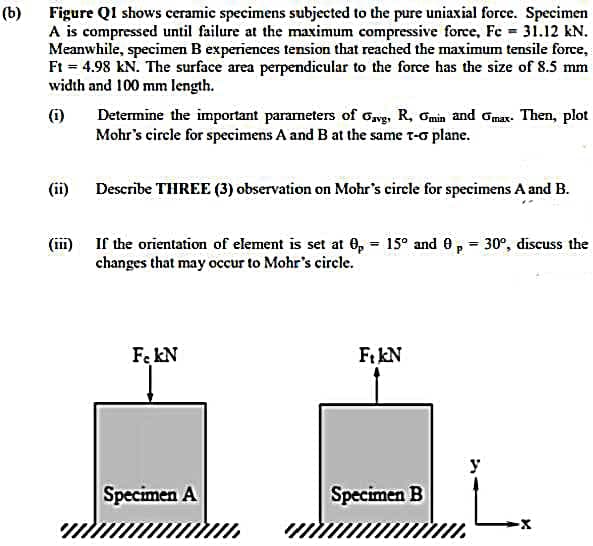b) Figure Q1 shows ceramic specimens subjected to the pure uniaxial force. Specimen A is compressed until failure at the maximum compressive force, Fe= 31.12 kN Meanwhile, specimen B experiences tension that reached the maximum tensile force Ft = 4.98 kN. The surface area perpendicular to the force has the size of 8.5 mm width and 100 mm length. (1) (ii) Determine the important parameters of Gavg, R, Gmin and Gmax. Then, plo Mohr's circle for specimens A and B at the same T-σ plane. Describe THREE (3) observation on Mohr's circle for specimens A and B. (III) If the orientation of element is set at 0,= 15° and 0 p = 30°, discuss the changes that may occur to Mohr's circle. F₂ kN Specimen A F₁ kN Specimen B y M
b) Figure Q1 shows ceramic specimens subjected to the pure uniaxial force. Specimen A is compressed until failure at the maximum compressive force, Fe= 31.12 kN Meanwhile, specimen B experiences tension that reached the maximum tensile force Ft = 4.98 kN. The surface area perpendicular to the force has the size of 8.5 mm width and 100 mm length. (1) (ii) Determine the important parameters of Gavg, R, Gmin and Gmax. Then, plo Mohr's circle for specimens A and B at the same T-σ plane. Describe THREE (3) observation on Mohr's circle for specimens A and B. (III) If the orientation of element is set at 0,= 15° and 0 p = 30°, discuss the changes that may occur to Mohr's circle. F₂ kN Specimen A F₁ kN Specimen B y M
Materials Science And Engineering Properties
1st Edition
ISBN:9781111988609
Author:Charles Gilmore
Publisher:Charles Gilmore
Chapter6: Introduction To Mechanical Properties
Section: Chapter Questions
Problem 6.2P
Related questions
Question
10

Transcribed Image Text:(b)
Figure Q1 shows ceramic specimens subjected to the pure uniaxial force. Specimen
A is compressed until failure at the maximum compressive force, Fe= 31.12 kN.
Meanwhile, specimen B experiences tension that reached the maximum tensile force,
Ft = 4.98 kN. The surface area perpendicular to the force has the size of 8.5 mm
width and 100 mm length.
()
(ii)
Determine the important parameters of Gavg, R, Omin and Omax. Then, plot
Mohr's circle for specimens A and B at the same T- plane.
Describe THREE (3) observation on Mohr's circle for specimens A and B.
=
(iii) If the orientation of element is set at 0, 15° and 9 p
changes that may occur to Mohr's circle.
Fc kN
Specimen A
1/
F₁ kN
Specimen B
= 30°, discuss the
y
Expert Solution
This question has been solved!
Explore an expertly crafted, step-by-step solution for a thorough understanding of key concepts.
Step by step
Solved in 3 steps with 2 images

Knowledge Booster
Learn more about
Need a deep-dive on the concept behind this application? Look no further. Learn more about this topic, civil-engineering and related others by exploring similar questions and additional content below.Recommended textbooks for you

Materials Science And Engineering Properties
Civil Engineering
ISBN:
9781111988609
Author:
Charles Gilmore
Publisher:
Cengage Learning

Steel Design (Activate Learning with these NEW ti…
Civil Engineering
ISBN:
9781337094740
Author:
Segui, William T.
Publisher:
Cengage Learning

Materials Science And Engineering Properties
Civil Engineering
ISBN:
9781111988609
Author:
Charles Gilmore
Publisher:
Cengage Learning

Steel Design (Activate Learning with these NEW ti…
Civil Engineering
ISBN:
9781337094740
Author:
Segui, William T.
Publisher:
Cengage Learning